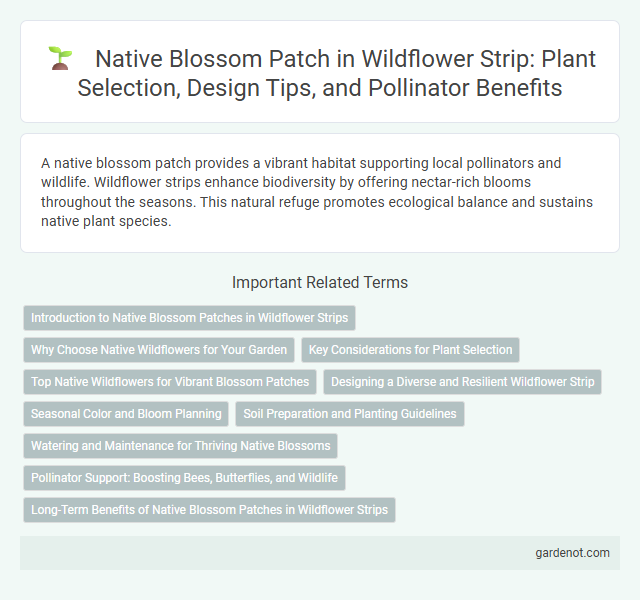A native blossom patch provides a vibrant habitat supporting local pollinators and wildlife. Wildflower strips enhance biodiversity by offering nectar-rich blooms throughout the seasons. This natural refuge promotes ecological balance and sustains native plant species.
Introduction to Native Blossom Patches in Wildflower Strips
Native blossom patches within wildflower strips provide essential habitats for pollinators such as bees, butterflies, and hummingbirds by offering diverse nectar sources throughout the growing season. These patches consist predominantly of indigenous plant species adapted to local soil, climate, and ecological conditions, enhancing biodiversity and ecosystem resilience. Integrating native blossoms supports natural pest control, soil stabilization, and promotes overall environmental health in urban and rural landscapes.
Why Choose Native Wildflowers for Your Garden
Native wildflowers support local ecosystems by providing essential nectar and habitat for native pollinators like bees and butterflies. These resilient plants require less water and maintenance compared to non-native species, promoting sustainable gardening practices. Choosing native blossoms enhances biodiversity and preserves the natural beauty unique to your region.
Key Considerations for Plant Selection
Selecting plants for a native blossom patch in a wildflower strip requires emphasizing regional adaptability and pollinator support to enhance local biodiversity. Prioritize native species such as Echinacea purpurea, Asclepias tuberosa, and Solidago canadensis, known for attracting bees, butterflies, and other beneficial insects. Ensuring soil compatibility and staggered blooming periods maximizes ecological benefits and aesthetic appeal throughout the growing season.
Top Native Wildflowers for Vibrant Blossom Patches
Top native wildflowers such as purple coneflower (Echinacea purpurea), black-eyed Susan (Rudbeckia hirta), and butterfly weed (Asclepias tuberosa) create vibrant blossom patches that support local pollinators and biodiversity. These species thrive in diverse soil types and climates, offering prolonged blooming periods that attract bees, butterflies, and birds. Incorporating a mix of native wildflowers enhances ecological balance and ensures a sustainable, colorful wildflower strip throughout the growing season.
Designing a Diverse and Resilient Wildflower Strip
Designing a diverse and resilient wildflower strip involves selecting native blossom patches that support local pollinators and enhance ecological balance. Incorporating a variety of native species such as Black-eyed Susan, Purple Coneflower, and Wild Bergamot ensures continuous bloom periods and habitat diversity. Strategic planting based on soil type, sunlight exposure, and moisture levels maximizes growth sustainability and ecosystem benefits.
Seasonal Color and Bloom Planning
Native blossom patches in wildflower strips are designed to maximize seasonal color and bloom continuity by selecting diverse species adapted to local climates. Planting a mix of early, mid, and late-season bloomers ensures vibrant visual interest from spring through fall, supporting pollinator activity year-round. Strategic bloom planning enhances ecosystem resilience and promotes sustainable habitat restoration.
Soil Preparation and Planting Guidelines
Preparing soil for a native blossom patch requires removing existing grass and debris, followed by loosening the soil to a depth of 6 to 8 inches for optimal root growth. Incorporating organic matter like compost enhances soil fertility and drainage, essential for native wildflowers' healthy establishment. Plant seeds according to species-specific depth and spacing guidelines, ensuring good seed-to-soil contact by gently pressing seeds into the soil and watering immediately after planting.
Watering and Maintenance for Thriving Native Blossoms
Consistent watering is essential during the establishment phase of a native blossom patch, with deep, infrequent watering promoting strong root development. Mulching around plants helps retain soil moisture, suppress weeds, and regulate temperature, reducing maintenance needs. Regular monitoring for invasive species and timely removal ensures the native flora thrives without competition.
Pollinator Support: Boosting Bees, Butterflies, and Wildlife
Native blossom patches in wildflower strips provide vital nectar and pollen sources that significantly boost populations of bees, butterflies, and other pollinators. These diverse floral habitats enhance biodiversity by offering continuous bloom cycles, essential for sustaining wildlife throughout the growing season. Incorporating native wildflowers increases pollinator activity, supporting ecosystem services like crop pollination and wildlife nourishment.
Long-Term Benefits of Native Blossom Patches in Wildflower Strips
Native blossom patches within wildflower strips enhance biodiversity by supporting pollinators such as bees, butterflies, and other beneficial insects crucial for ecosystem health. They improve soil quality through natural nutrient cycling and reduce erosion, promoting sustainable land management. Establishing native species in these patches ensures long-term resilience against pests and climate variability, fostering a stable environment for wildlife.
Native blossom patch Infographic

 gardenot.com
gardenot.com